I spent New Year in Catania almost by accident—I hadn’t even heard of the city before planning this trip. It wasn’t on my radar, and definitely not what I pictured when I thought “New Year in Sicily.” But that’s what made it perfect. I wanted somewhere with mild winter weather—cool but not cold, quiet but not dead. Catania delivered all of that—and then some. Known as “La Città Nera” (The Black City), it’s built from black lava stone left by Mount Etna’s many eruptions. The result? A moody, dramatic city that doesn’t try to charm you—but somehow still does. I came for a peaceful New Year. What I got was fireworks, folklore, food comas, and beautiful, unpredictable chaos.
Day 1: A Rocky Arrival and Rooftop Views
I arrived in Catania by train, coming from the picturesque hill town of Taormina—a place that had already left me a little spellbound. (Read about my one-night stay in Taormina here). I thought I had mastered the art of navigating Sicily’s rail system by now. My heavy luggage begged to differ. Despite my best efforts to pack light, the combo of poor restraint and enthusiastic early-trip shopping tipped the scales.
The taxi ride into the city center felt ominous—not because of the driver, but the scenery. Catania didn’t exactly greet me with a warm embrace. The roads felt rough, the buildings imposing. Reaching my Airbnb meant walking through a back alley and arriving at a large, heavy door. When it slammed shut behind me, the echo thundered up three…flights…of…stairs.
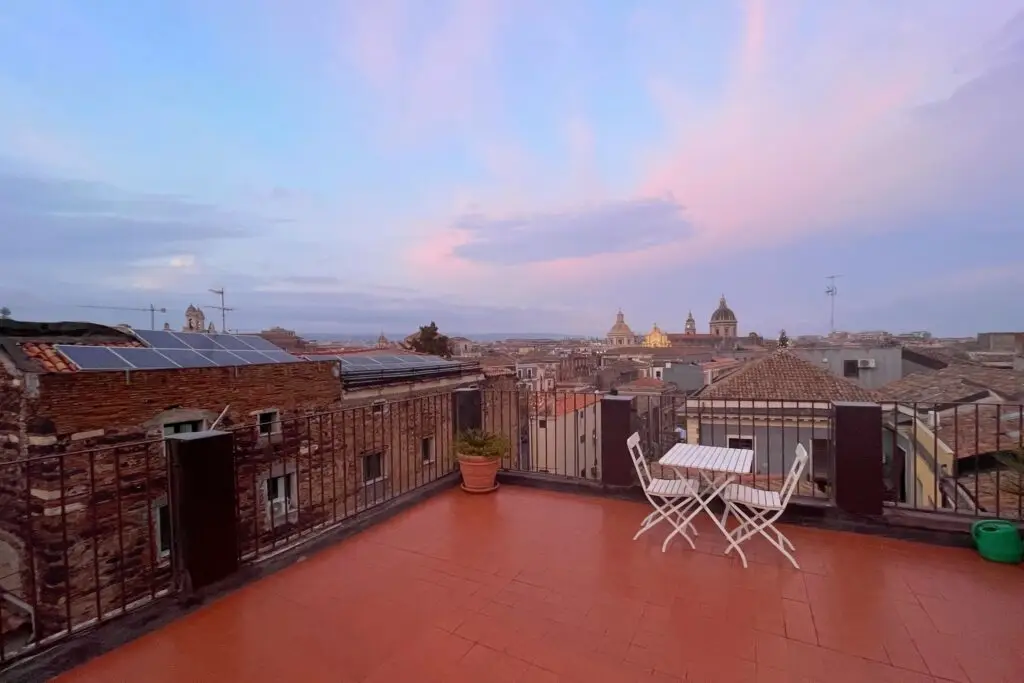
Inside, my temporary home was a splurge for New Year’s week. Stylish and compact, but what really sold me was the rooftop terrace. Except—plot twist—it wasn’t actually inside the apartment. To get there, I had to venture up another narrow, dim staircase and struggle with an ancient wooden door that looked like it hadn’t been opened since the Spanish Inquisition. I half expected it to creak open into Narnia. Instead, it opened into something real: sweeping rooftop views with the Cathedral of Saint Agatha (Basilica Cattedrale di Sant’Agata) in sight, and on clear days, even Mount Etna in the distance.
That evening, I took a short walk to stretch my legs and find dinner. Five minutes outside, and the city began to soften. Though the Fish Market (La Pescheria) had closed, the streets were full of locals doing what they do best—passiagare—slow, social strolling that seemed like an art form. It was the eve of New Year’s Eve, and Catania was beginning to show its charm.
Day 2: Mount Etna, Fireworks, and Honey Dreams
I joined a group tour to Mount Etna. The drive up was bathed in sunshine, the volcano’s snowy peaks glowing like a giant powdered cannoli in the sky. But as we reached the base for the hike, the fog rolled in like it had booked a ticket just to ruin the view.
Still, the adventure didn’t disappoint. We hiked across ancient lava fields, admired the eerie otherworldliness of the landscape, and even ventured into a lava cave with helmets and torches—the kind of place you’d expect to find a dragon or at least a lost hiker from 1983—but all we saw was a lone bat.
We wrapped up at ORO d’Etna, a family-run haven for wine, olive oil, and honey. I sampled everything like it was my job and walked away with two small jars of melon-infused honey cream. To this day, I mourn the fact that I didn’t buy the large jar. It was like sunshine and dessert had a baby. (Anyone care to get me some?)
After the tour, I returned to Catania and stocked up on snacks and breakfast goods, bracing for everything to shut down in preparation for New Year’s Eve. I had no idea what kind of night I was in for.
By 9:30 PM, the fireworks had begun—sporadic flares lighting up rooftops across the city, with the buzz of anticipation thick in the air. From my balcony, I could hear the concert downtown.
At 11:30 PM, I was fiddling with my 360 camera from the rooftop terrace I had so thoughtfully chosen specifically for its prime view of the Cathedral of Saint Agatha (Basilica Cattedrale di Sant’Agata)—thinking it would be the best spot to witness a grand, central fireworks display. Instead, it felt like I was positioned for the wrong act in a chaotic theatre. As I tried to set up my gear, I spotted a hand down the side of the building holding a gun. Blanks, I hope. Maybe. Let’s just say it added to the ambience.
While ducking from rogue flares launched by the neighbors, I realized the real fireworks show wasn’t happening at the Duomo—it was exploding all around me. It was beautiful, chaotic, and very, VERY loud.
By midnight, I was cowering behind a rooftop wall like a skittish cat while holding my phone in the air, filming without looking. Forget “photo of the year.” This was survival content. What I hadn’t expected was that the real action wouldn’t be in the distance—it would be exploding all around me like a cinematic war zone. The sky was ablaze in every direction. It wasn’t just a fireworks show—it was a full-blown sensory assault. A stunning, disorienting, very Sicilian cultural shock.
The fireworks didn’t end at midnight. They carried on, sporadically, like popcorn in a microwave until morning.
Day 3: San Berillo, Pasta Cravings, and Strike Two
New Year’s Day was quiet. Most of the city had shut down. I wandered into the San Berillo neighborhood—once a red-light district, now known for its evolving street art scene, creative studios, and small eateries tucked into narrow lanes.
I tried to eat at De Fiore Nuova Trattoria del Forestiero. It was closed—thanks, Google, for once again proving unreliable when it comes to operating hours in Italy.
I eventually found a seat at L’Oste Pazzo, located in what appeared to be a Nigerian neighborhood—there were a couple of Nigerian shops nearby—where I had a decent version of Catania’s beloved Pasta alla Norma. Warm, comforting, and exactly what I needed on a slow holiday afternoon.
After lunch, I kept walking, snacked on baked goods from a kiosk I can no longer name, and called it an early night. The city still felt like it was in recovery mode from the previous night’s fireworks madness—and honestly, so was I.
Day 4: The Godfather Tour, Teatro Romano, and a Pasta Revelation
I took the train back to Taormina for a tour I had long been looking forward to.
The Godfather Tour from Taormina was, without a doubt, a highlight. Our guide, the charismatic Marcello, delivered trivia with the flair of someone who could’ve easily played a consigliere if casting had gone his way. We were a small group—just myself and a lovely British couple, Dawn and Brett—meaning there were no crowds to block my movie reenactment fantasies.
The Godfather wasn’t filmed in Corleone. Francis Ford Coppola chose Savoca and Forza d’Agrò for their more authentic, less developed, and “sleepy” atmosphere. These locations were able to convey the period setting more effectively.

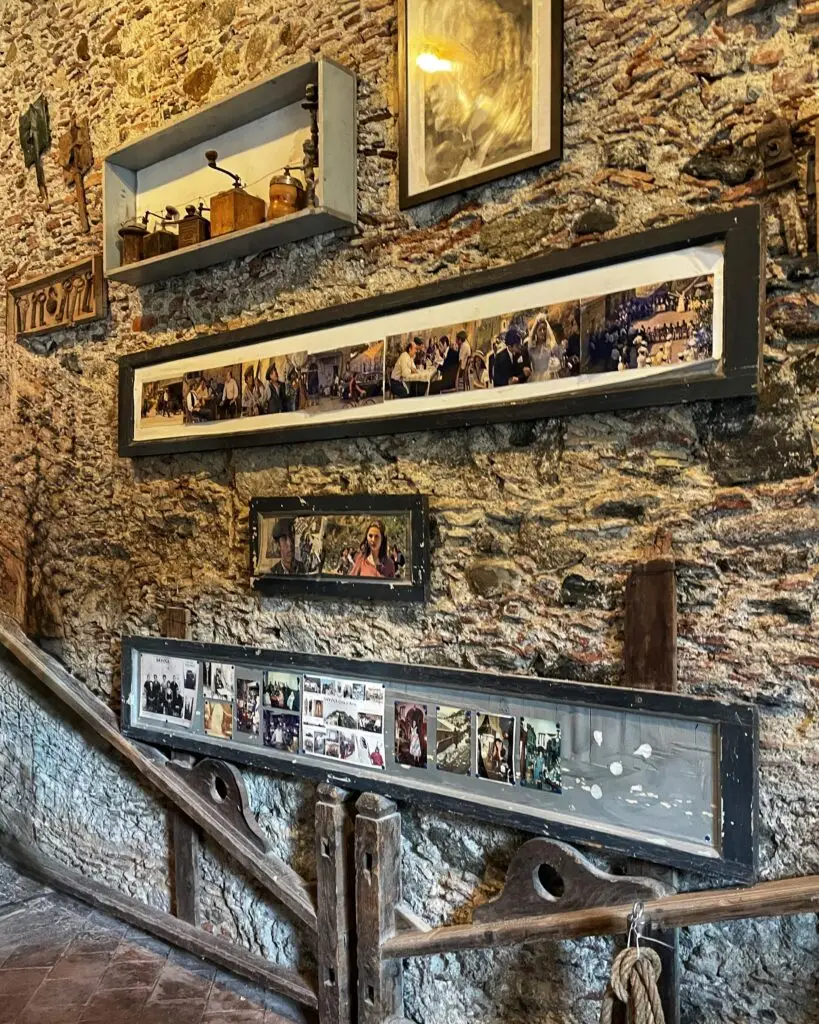
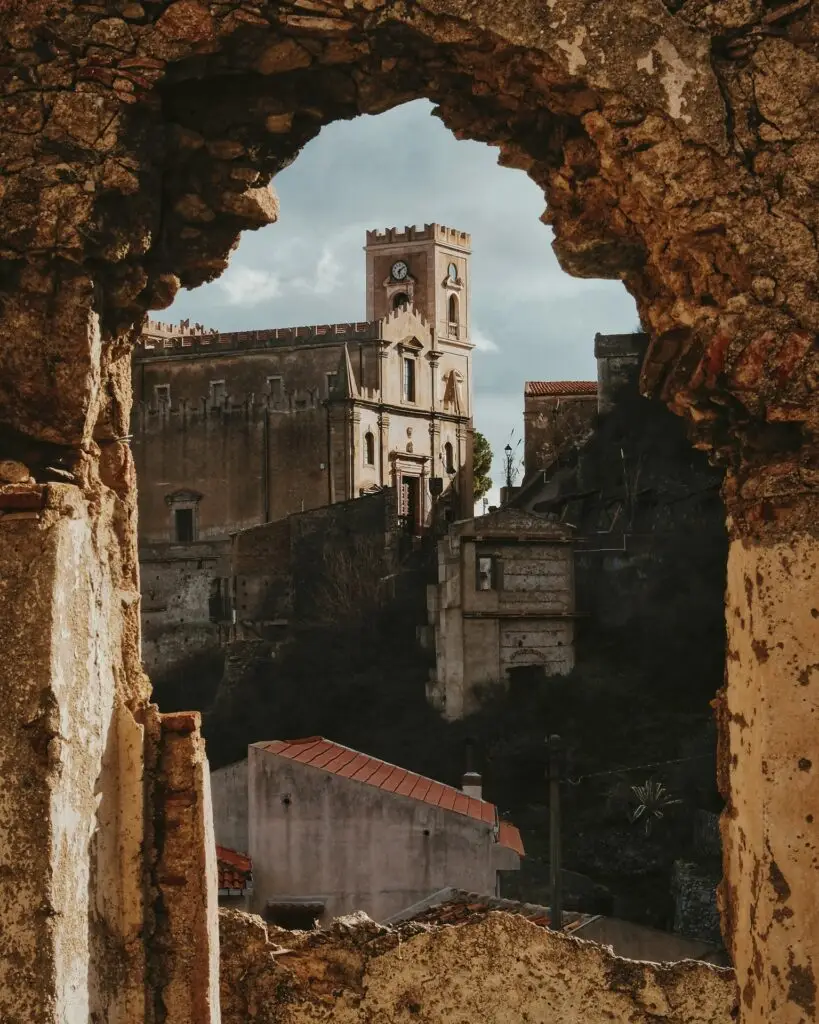
Savoca
Savoca felt suspended in time. We climbed the sleepy hilltop village streets. The air was cool and still, the kind that carries whispers from centuries past. We visited Bar Vitelli, the iconic filming location where Michael Corleone first meets Apollonia’s father—already famous for its lemon granita and local biscuits even before Coppola made it immortal.
Cats dozed lazily in the bushes, the sun casting soft light through the vined pergolas that made the old stone walls glow. Inside the bar were vintage photos and memorabilia from the film—framed echoes of fictional history.
Later, we walked to the Church of Saint Nicholas (Chiesa di San Nicolò), perched quietly above the town, where Michael and Apollonia’s wedding scene was filmed (though no scenes were actually shot inside—everything happened on the steps outside). The whole place felt like a living set that hadn’t been touched since the cameras stopped rolling.
Forza d’Agrò
Just a 15-minute drive away, this authentic medieval village stood in for Corleone in the film. Marcello, true to form, promised us “the best view” at every stop—each one somehow more breathtaking than the last. Its narrow cobblestone lanes and panoramic views made it an ideal filming location. With a population of only around 800, the streets were especially peaceful, adding to the dreamlike quiet. Honestly, I could get used to that high-altitude stillness.
It was photogenic, quiet, and felt like stepping into a time capsule—or at the very least, the DVD extras of a Godfather box set.
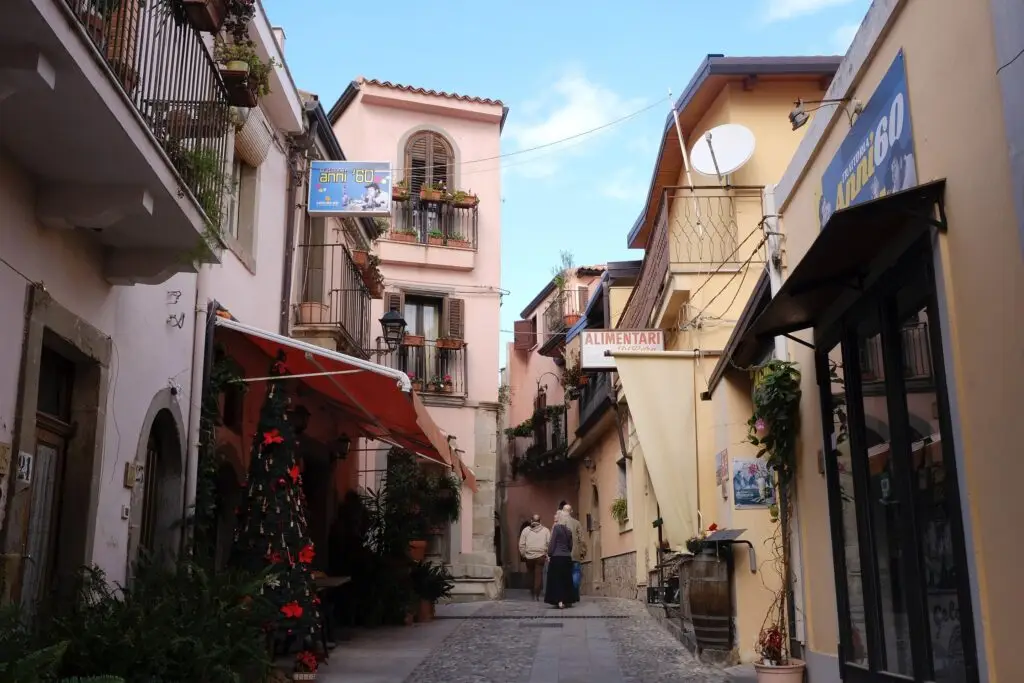

Back in Catania, I made my second attempt at De Fiore Nuova Trattoria del Forestiero. Still closed.
Hungry and undeterred, I wandered into Ciauru i Mari. And there it was—the best Pasta alla Norma of my entire trip. Creamy, balanced, and perfectly seasoned. It had that elusive homemade feel—like someone’s nonna had just stepped out of the kitchen and left it there for you.

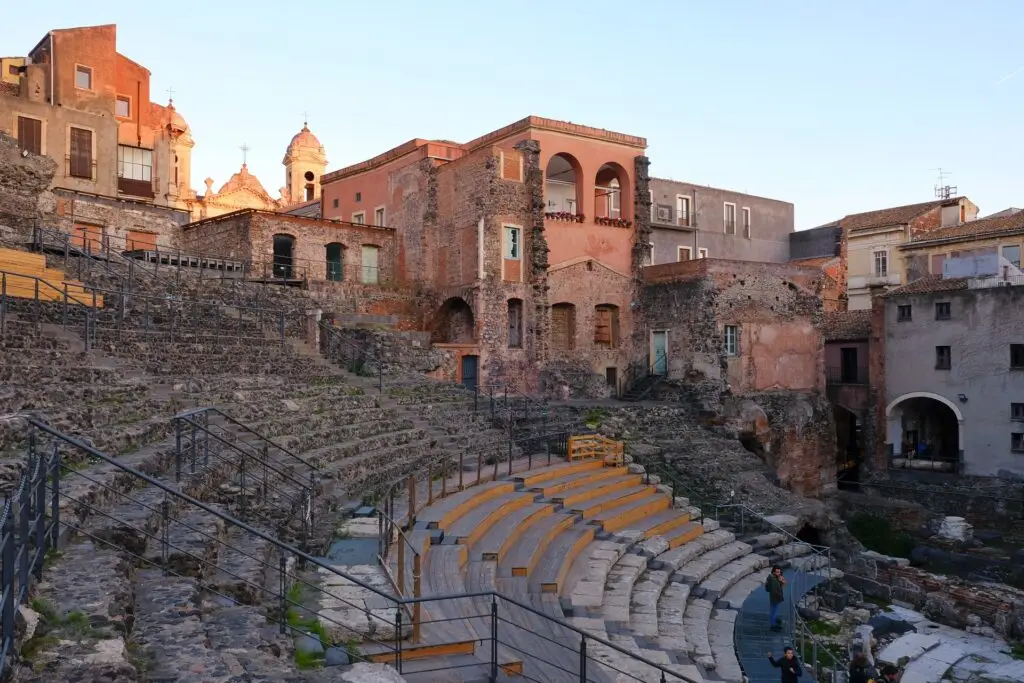
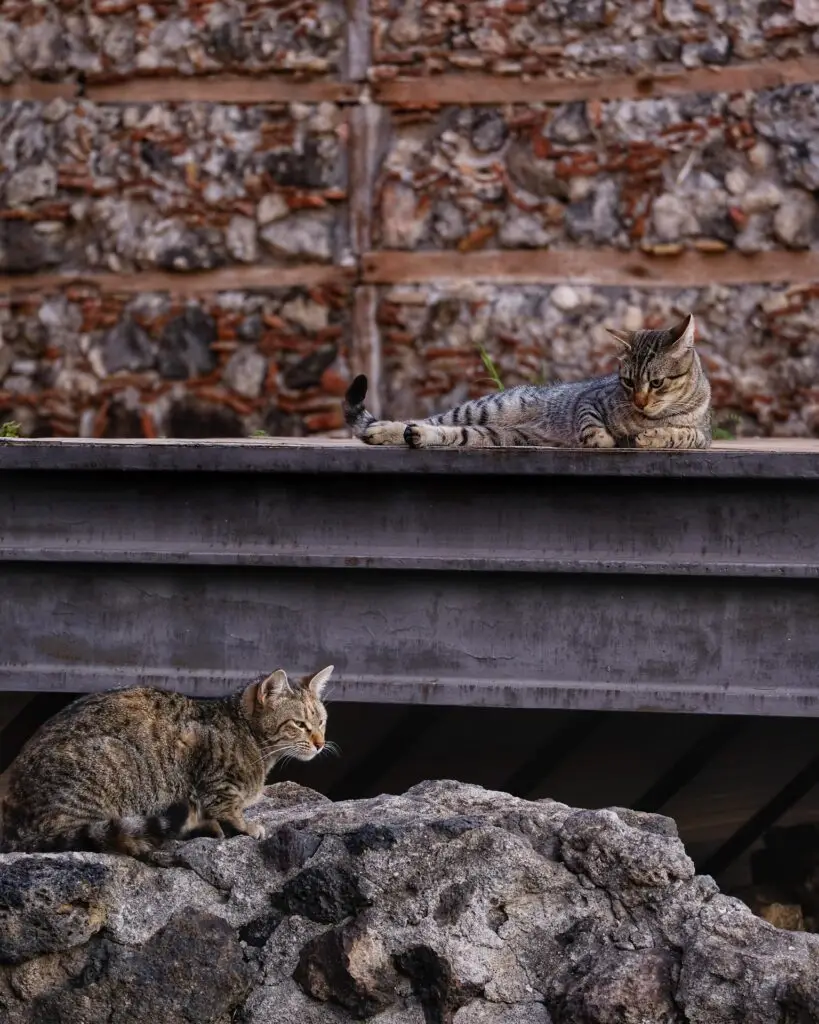
With time to spare and a full belly, I finally visited Roman Theatre (Teatro Romano), a tucked-away archaeological site I had unknowingly walked past several times. From the street, it looked like just another row of old buildings. But behind a nondescript facade lay a compact Roman theatre—its ancient stone seating wrapped snugly into the urban fabric of Catania.
Cats lounged lazily along the ruins, blending in like they belonged to another era.
Fun fact: the Roman Theatre (Teatro Romano) dates back to the 2nd century AD and could once hold over 7,000 spectators. Today, it feels like a secret only those who wander are lucky enough to find.
Day 5: Ancient Ruins and Finally, Nonna’s Kitchen
My final full day began with a quick visit to the Fish Market (La Pescheria)—finally in full swing after the long holiday lull. Vendors were in full voice, and the place was alive with activity. I stayed just long enough to snap a few photos and soak in the vibrant energy before setting off to meet the day’s tour group.
Along the way, I made a new friend—a solo traveler from Australia—and we decided to explore the sites together.
Our destination: the Valley of the Temples (Valle dei Templi), a UNESCO World Heritage Site filled with some of the best-preserved Greek temples in the world. Among them is the Temple of Concordia, an incredibly intact Doric temple dating back to the 5th century BC. Almost all its columns still stand, making it one of the most impressive ancient structures in all of Sicily.

Next stop: Villa Romana del Casale, famed for its vast collection of Roman mosaics—over 3,500 square meters of intricate storytelling through tile. Mythology, hunting scenes, domestic life—it’s all there, frozen in colorful detail.
That evening, finally, De Fiore Nuova Trattoria del Forestiero was open! It was still early by Italian standards, but I wasn’t taking any chances.
Founded in 1962, the trattoria is run by Mamma Rosanna and her son. Mamma Rosanna herself was right there in front of me—in the flesh, no less—though it was her son who served me that evening.
The Pasta alla Norma? It’s been voted the best in all of Catania—classic and steeped in tradition. But for me, Ciauru i Mari still held the crown.
Day 6: Farewell, Catania
With a little more time on my hands, I made one last visit to the buzzing Fish Market (La Pescheria). In the crisp morning air, the absence of any “fishy smell” surprised me—likely thanks to the cold weather. Men hawked their catch with flair, and I stood on the sidelines and observed, camera in hand, soaking in the heartbeat of Catania one last time.

Late checkout secured, transit anxiety eased slightly, I packed up for the next leg of my Sicilian adventure—grateful for the chaos, charm, and unexpected cultural fireworks of this gritty, lava-stoned city.
Final Thoughts
Catania surprised me. What started with a daunting arrival turned into a chaotic, colorful, and unforgettable celebration of Sicilian life. Fireworks, food, folklore, and films—this city served up an experience I won’t forget. And yes, I’d go back for that honey.
That said, I left knowing I hadn’t seen it all. I didn’t get a chance to step inside the Cathedral of Saint Agatha (Basilica Cattedrale di Sant’Agata), and several places I’d bookmarked were either closed for the holidays or just didn’t make it into the itinerary. Maybe it’s a sign—I’ll have to come back and give Catania the proper re-do it deserves.
Plan Your Own Trip to Catania
Here’s a handy overview to help you plan your own visit—especially useful if you’re going during the quieter holiday season when some spots may be closed or operate on limited hours
Visits
- Mount Etna – Sicily’s iconic volcano. Book a guided tour to explore lava fields, hike craters, and visit honey and wine producers. I did this tour with Get Your Guide and highly recommend it.
- Cathedral of Saint Agatha (Basilica Cattedrale di Sant’Agata) – The grand heart of the city. I didn’t manage to go inside this trip, but it’s a must on my list for next time.
- Piazza Duomo & Elephant Fountain (Fontana dell’Elefante) – The city’s central square and spiritual core. The lava-stone elephant statue—known locally as u Liotru—is Catania’s quirky, symbolic mascot, perched beneath an Egyptian obelisk. Legend and mystery wrapped into one odd little monument.
- Roman Theatre (Teatro Romano) – A compact archaeological site hidden in plain sight. Free to enter and perfect for quiet wandering among ancient stones and sleepy cats.
- Fish Market (La Pescheria) – Arrive early to catch the energy of this lively market. No frills, just character, shouting vendors, and glistening fresh catch.
- Fera ‘O Luni – One of Catania’s oldest weekday markets located in Piazza Carlo Alberto. I missed it due to holiday closures, but it’s known for everything from produce to clothing and kitchenware.
- Well of Gammazita (Pozzo di Gammazita) – Visible from the balcony of my Airbnb, this dark, eerie well is tied to a local legend of a young woman who chose death over dishonour. It’s easy to miss but fascinating to spot if you’re nearby.
- San Berillo District – If time allows, this former red-light area now features colorful murals, indie cafes, and a grittier creative vibe. Worth exploring for those interested in street art and urban regeneration.
Day Trips from Catania
- Savoca & Forza d’Agrò (The Godfather Tour) – a tour is a good way to cover more ground. Coppola filmed here instead of Corleone. Peaceful, scenic villages with gorgeous views and cinematic trivia. Easiest to visit on a guided tour from Catania or Taormina. I did this tour from Catania.
- Valley of the Temples (Valle dei Templi) & Villa Romana del Casale – Also referred to as Piazza Armerina. You can book this tour online, but I secured mine in person at the Tourist Service box office next to the Cathedral of Saint Agatha. These tours provide driver service only—you cover your own entry fees. A stress-free way to avoid multiple transfers or getting lost.
Eat
- Ciauru i Mari – My favourite Pasta alla Norma spot. Creamy, flavourful, and deeply comforting. Also known for their fresh seafood dishes. Location map
- De Fiore Nuova Trattoria del Forestiero – A long-standing local trattoria run by Mamma Rosanna and her son. Old-school Sicilian warmth and hearty, traditional fare. Also known for the best Pasta alla Norma. Location map
- L’Oste Pazzo – I found this spot on New Year’s Day, when most of the city was shut. Casual, friendly, and a welcome place to grab a comforting plate of pasta.
- Street food near Via Gisira – Around the Fish Market, you’ll find kiosks and vendors offering everything from arancini to baked goods. A great way to snack your way through the old town. Location map
Shop
- Via Etnea – The city’s main commercial street. You’ll find everything from high-street fashion to souvenir stalls and even luxury labels. Perfect for casual strolling and people-watching.
- ORO d’Etna – If you’re joining a Mount Etna tour, this is usually one of the tasting stops. Otherwise, visit independently to buy honey, olive oil, and wine. I still regret not getting the big jar of melon honey. Location map
- Vetriamo – A small stained glass shop I stumbled across—closed for the holidays, but the beautiful items I spotted through the window were enough to warrant a return.
Stay
- Centro Storico (Historic Centre) – Ideal for first-timers. Walking distance to most landmarks, lots of charm (and stairs), and lively piazzas.
- Via Etnea area – A bit more polished, with easy access to shops, public transport, and cafes. Quieter in the evenings.
- Fish Market / Duomo area – Atmospheric and central, though more active and sometimes noisy. Best for foodies and photographers.
- Rooftop Airbnb near the Duomo – I stayed here for the fireworks views. Very close to the Fish Market/Duomo area. The terrace overlooked the Well of Gammazita and gave me one of the most memorable New Year’s experiences of the trip.
Getting Around
- Tours – For Mount Etna, The Godfather villages, and Valley of the Temples, consider a GetYourGuide tour. It’s easier than piecing together public transport, especially if you’re short on time or not fluent in Italian.
- Trains – Convenient connections to Taormina, Siracusa, Palermo, and other parts of Sicily. Book in advance during holidays.
- Walking – Catania is wonderfully walkable, but the lava-stone streets can be uneven—wear good shoes.
- Buses – Public buses are available but may run reduced schedules on Sundays and holidays.
Keep Exploring Sicily
If you enjoyed this story, you might also like:
- Taormina in Winter: A Solo Traveler’s Peaceful Escape
- Why I Fell in Love with Ortigia, Sicily – A Solo Travel Guide & Story
- Winter in Palermo – A Travel Story of Rain and Resilience
Along the way, I squeezed in unforgettable side trips to places like Savoca, Ragusa, Modica, Cefalù, and Noto. Each one added a different color to the Sicilian palette.
